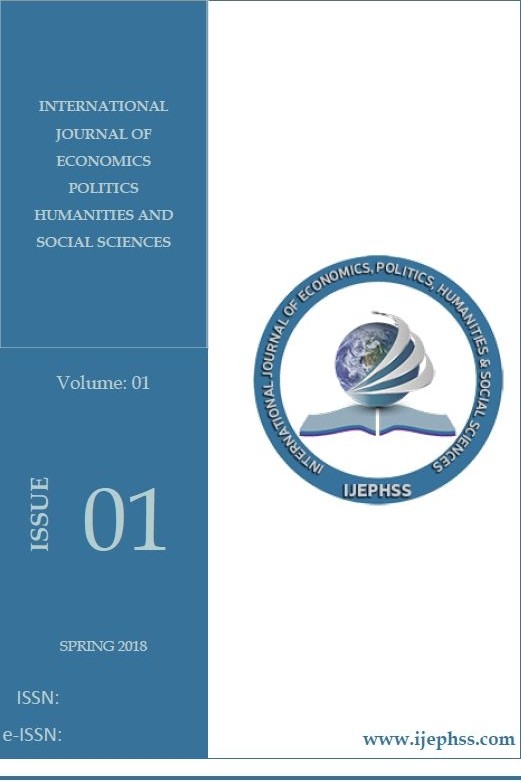Modern Dünya Sistemine Entegrasyon: Çin
Bu makale, Çin'in Modern Dünya Sistemi’ne, kapitalist dünya ekonomisine, entegrasyon sürecinin nasıl meydana geldiğini sorgulayarak sistem entegrasyonu kavramını ve örnek olay olarak Çin ekonomisini analiz etmek amacıyla yazılmıştır. Öncelikle teorik temelin önemi gözetilerek literatür bilgisine yer verilmiştir. Devamında Çin’in ekonomik tarihinden kısaca bahsedilerek günümüze kadar yaşadığı ekonomik sistem değişikliği gösterilmek istenmiştir. Bu çalışmayı okuyanlar, Kapitalist Dünya Ekonomisi ve Çin'in bu yapıdaki yeri hakkında genel bilgi edineceklerdir.
Anahtar Kelimeler:
entegrasyon, dünya sistemleri, politik ekonomi, Çin
INCORPORATION TO MODERN WORLD SYSTEM CASE STUDY: CHINA
This article is organized to analyze concept of incorporation and China as a case study through inquiring how the process of integration of China to the Modern World System- Capitalist World Economy occured. Firstly theoretical basis is tried to be emphasized and then following the subject of China’s brief historical bacground, it is examined the main characteristics and some statistics of China’s economic change before concluding remarks. Those who reads this work will be able to find general information about the Capitalist World Economy, Incorporation concept and China’s place in this structure. There is a wide range of literature on the history and economic power of China, and all these resources have helped a lot to analyze this work. China's increasingly massive economic share shows that the world system needs to be questioned and some analysis is needed. In this study, it is analyzed whether there is an overlap between China's ideological identity and its place in the world system (claimed) and the integration process.
Keywords:
incorporation, world-systems theory, political economy, China,
___
- 1983: Household Responsibility System. (2009, September 16). China.Org.Cn: http://www.china.org.cn/features/60years/2009-09/16/content_18534697.htm adresinden alındıArrighi, G. (March-April 2005). HEGEMONY UNRAVELLING—1. New Left Review 32.Arrighi, G. (May-June 2005). HEGEMONY UNRAVELLING—2. New Left Review 33.Chase-Dunn, C. (1978). Core-Periphery Relations: The Effects of Core Competition. In B. H. (Editor), Social Change in the Capitalist World Economy. Beverly Hills: SAGE Publications.Cienciala, A. M. (1999). The Rise and Fall of Communist Nations 1917-1994. Kansas: University of Kansas.Deng, K. (2000). Great leaps backward: poverty under Mao. London: London School of Economics and Political Science & Columbia University.Gökdemir, L., & Saray, M. (2007). ÇİN EKONOMİSİNİN BÜYÜME AŞAMALARI (1978-2005). Journal of Yaşar University.Hobsbawn, E. J. (1999). Industry and Empire: From 1750 to the Present Day. Penguin.Joint Economic Committee. (1982). CHINA UNDER THE FOUR MODERNIZATIONS. Washington: JOINT ECONOMIC COMMITTEE Congress of the United States.Minqi, L. (2008). The Rise of China and the Demise of the Capitalist World-Economy. London: Pluto Press.Peled, M. X. (Yöneten). (2006). ChinaBlue [Sinema Filmi].Phillips, T. (2016, May 11). The Cultural Revolution: all you need to know about China's political convulsion. The Guardian : https://www.theguardian.com/world/2016/may/11/the-cultural-revolution-50-years-on-all-you-need-to-know-about-chinas-political-convulsion adresinden alındıStiglitz, J. E. (Yöneten). (2013). why(,) globalization fails ? [Sinema Filmi].Tam, O. K. (2006). Financial Reform in China. S. Gabriel içinde, Chinese Capitalism and the Modernist Vision (s. ch.2). Routledge.Wallerstein, I. (1976). The Modern World-System: Capitalist Agriculture and the Origins of the European World-Economy in the Sixteenth Century. New York: New York: Academic Press.Wallerstein, I. (2009). World System Theory. SocioSite: http://www.sociosite.net/topics/texts/wallerstein_summary.php adresinden alındıWallerstein, I. (2010). How to Think About China.Watkins, T. (2002). San José State University . San José State University Department of Economics: http://www.sjsu.edu/faculty/watkins/greatleap.htm adresinden alındıYörük, E. (2018). Çin’in Yükselişi ve Yeni Kapitalizm. Sosyoekonomi, 197-208.
- Başlangıç: 2018
- Yayıncı: Onur OĞUZ
